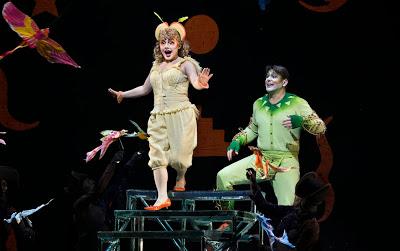by Paul J. Pelkonen
Twitter feed: Ashley Emerson (left) and Nathan Gunn as Papagena and Papageno in The Magic Flute.
Photo by Marty Sohl © 2013 The Metropolitan Opera.
Does cutting the Overture, the best Act I tune ("Bei mannern") and the highly dramatic duo for the Two Men in Armor constitute making Flute "family-friendly?" It certainly makes for a duller and less impressive evening. And judging from the restless kids populating the seats at the back of the Orchestra, the idea of presenting the show as a Salome-like marathon with no breaks for rest room, snack bar or Metropolitan Opera Gift Shop visits may be too much for future would-be opera-goers. Really, aren't they trying to make money?
The production selected for truncation is Julie Taymor's 2004 show. For her first production at the Met, Ms. Taymor re-imagined the mythical Egypt of the libretto as a dark, oppressive series of Lucite caverns, relieved only by the occasional bright yellow backdrop. The performance is populated with the director's trademark shadow puppets, which stand in for everything from an impressive and menacing bear to an ice-cream cone lowered tantalizingly in front of the bird-catcher Papageno.
Although he had one of his best numbers excised and his songs (mostly) reduced by one stanza each, Nathan Gunn made an entertaining Papageno the center of this show. Conscious of his younger audience, he played Mozart's naturmensch as a good-natured rustic, keeping the sexual allusions to a minimum and playing the character's near-suicide at the end of the opera for the maximum amount of laughs. This was an engaging performance from the baritone, at his best in the final scenes when he finally gets his Papagena (Ashley Emerson.)
These "family-friendly: affairs are often a chance to hear hot new voices. Of the young cast, the most impressive was soprano Albina Shagimuratova in her second Met outing as the Queen of the Night. This massively ungrateful coloratura part rang out with a fierce joy and every difficult high warble in place. Ms. Shagimuratova sounded like she was starting to run out of oxygen at the end of Die Hölle Rache but overall this was a strong performance.
Pamina was soprano Heidi Stober, who with "Bei Mannern" had very little opportunity to establish herself as anything more than a desirable object in a pretty costume. Her interactions with the tenor Alek Shrader proved them to be the duller of the opera's two romantic couples, but that is so often the case with Magic Flute. For his part, Mr. Shrader sounded relieved at only having to sing the first part of "Die Bildnis", and did his best to combat Ms. Taymor's Japanese hunting costume (she took the libretto literally) throughout the evening.
Eric Owens, recovered from recent vocal maladies was a welcome, sturdy Sarastro, with resonant notes and a calm, centering presence that is needed for this crucial role. Tenor John Easterlin was shrill and objectionable--in other words, perfect for Monostatos, the opera's cardboard villain/underling. Finally, the Met orchestra and chorus played with energy and vigor under the baton of Jane Glover. Although considering that this was the veteran conductor's Met debut, it would have been nice if they'd let her conduct the Overture.


